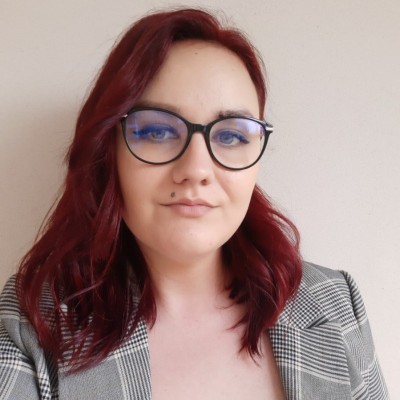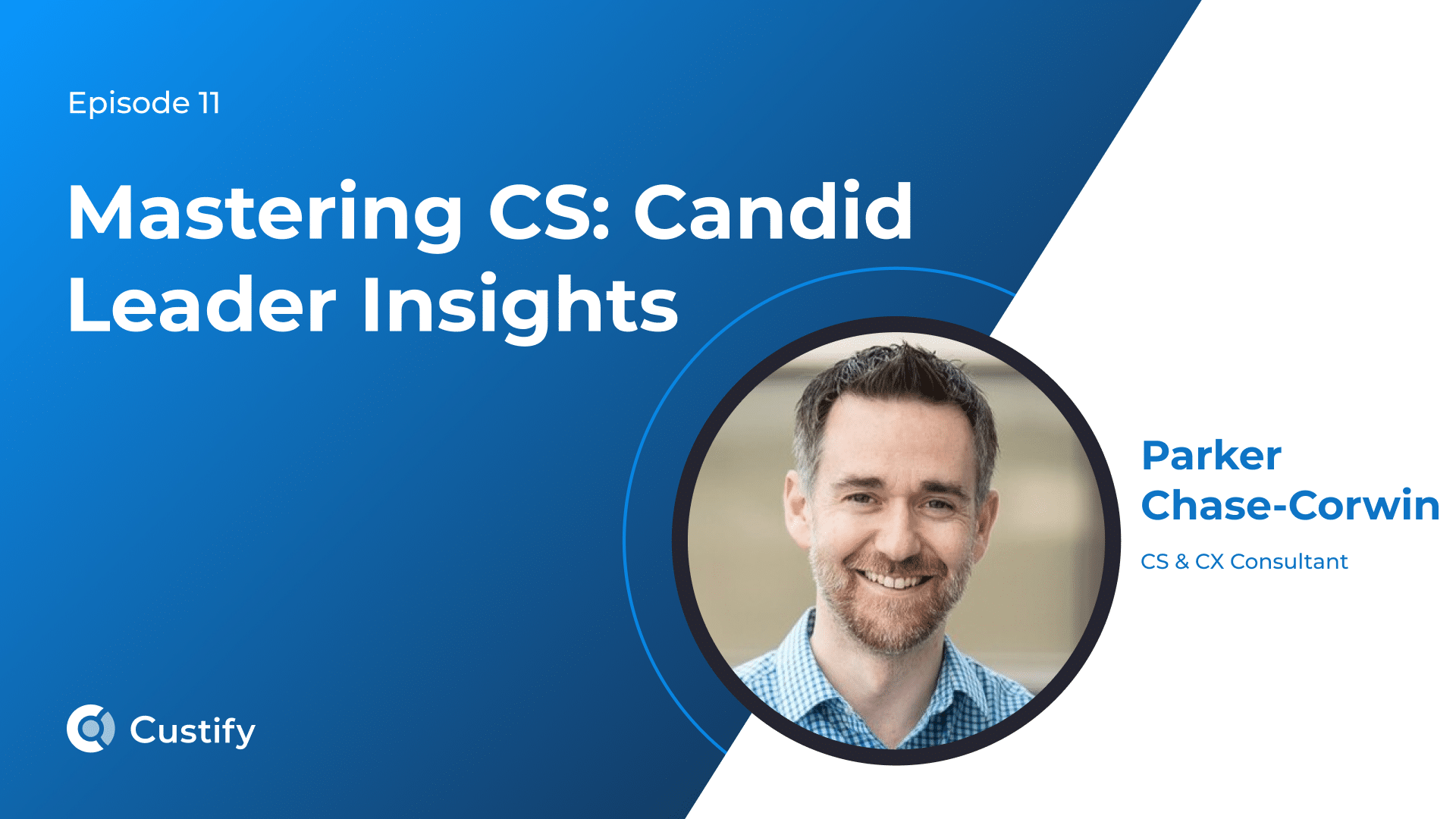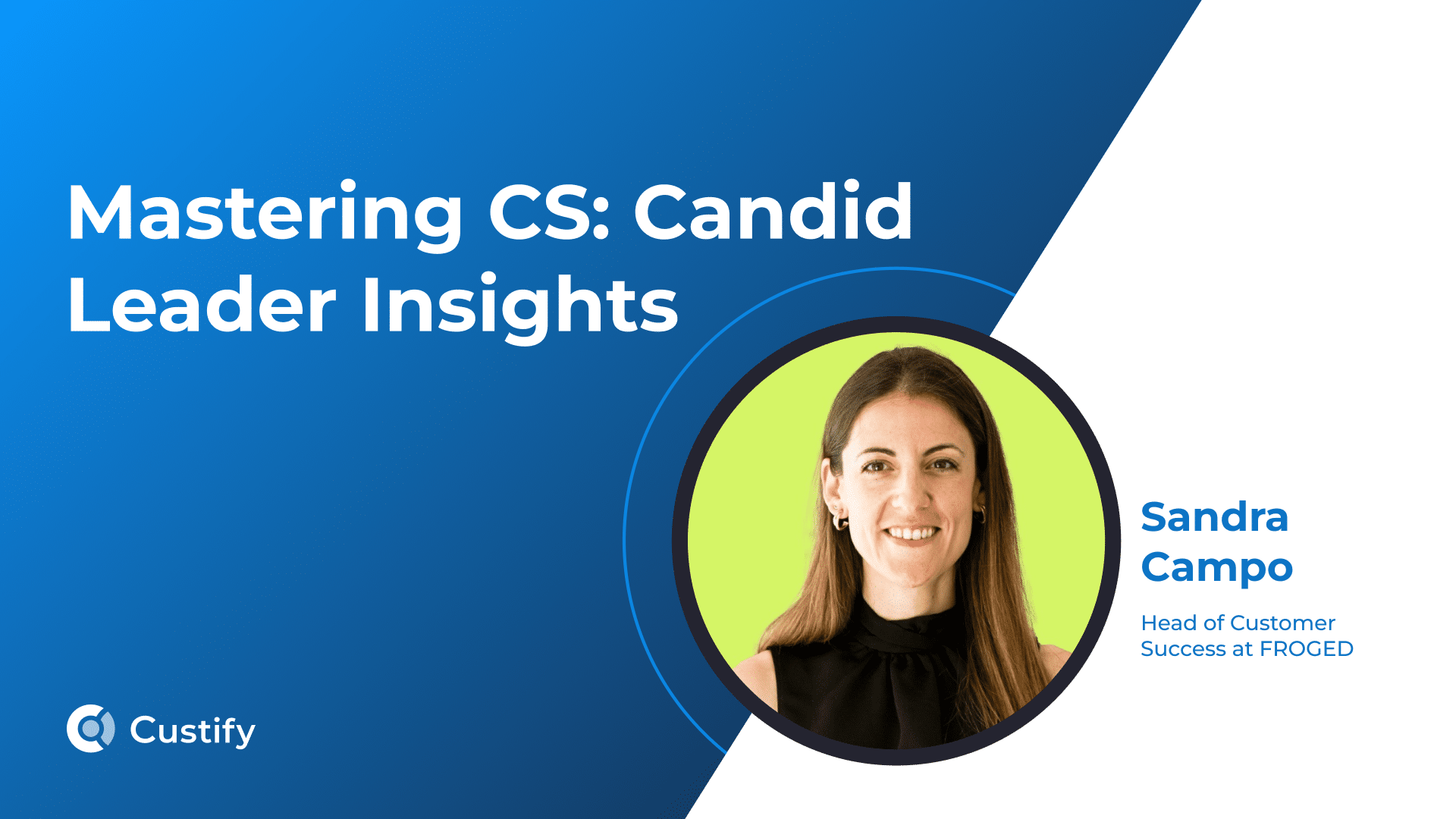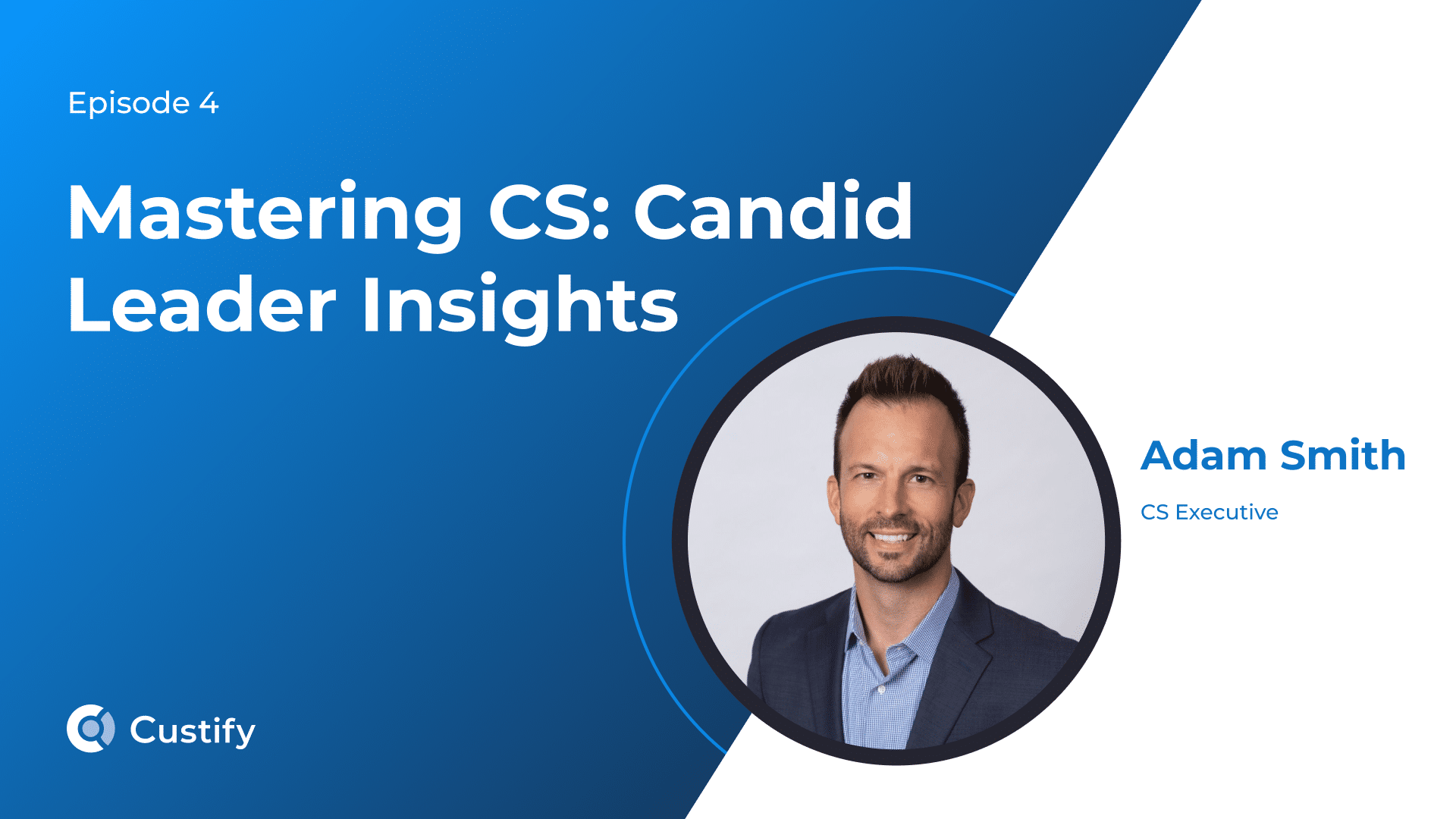In our new episode of the Mastering CS, Candid Leader Insights podcast, Irina Cismas, Head of Marketing at Custify, discussed with Sara Arecco, the Head of Customer Success at Antavo.
Sara talks about her amazing journey in CS, the challenges she overcame, and the strategies she implemented.
What You’ll Learn:
- How to structure the CS customer success team
- What are the right skills for CS
- The importance of the right tool stack for CS
- How to overcome customer challenges
- How to motivate your CS team
Key insights and takeaways for CSMs based on the interview:
Customer Success as a Revenue Driver: Sara emphasized that customer success is not just a cost center, but a revenue center, highlighting the importance of owning renewals and upsells to demonstrate clear financial value.
Prioritizing Communication and Team Alignment: Regular touchpoints, such as weekly kickoff meetings and quarterly account planning, are crucial for maintaining alignment and ensuring the team focuses on the right KPIs to drive impact.
Building Strong Cross-Department Collaboration: Effective customer success requires close collaboration with other departments like product, engineering, and sales. Sara stressed the importance of maintaining communication flow to prevent misalignment and ensure smooth processes.
The Role of Technology and AI in CS: While Sara’s team primarily uses basic tools like spreadsheets and HubSpot, they are experimenting with AI for automating tasks such as meeting summaries, which improves efficiency. However, they are still exploring more AI tools that could meet their specific needs.
Podcast transcript
Irina 00:01
Welcome to Mastering CS – Candid Leader Insights, the podcast where we deep dive into the world of customer success with industry leaders. I’m your host, Irina Cismas, and today’s guest is Sara Arecco, Head of Customer Success at Antavo.
Sara, welcome and thanks for joining us today. I’d love to hear about your story. I know you started out in sales. What actually inspired you to make the switch to customer success? How did you end up in CS?
Sara 00:31
Yeah, absolutely. So I started my career in sales, as you said, but I transitioned into more of an account management role at some point. I developed a strong desire to move away from transactional interactions and focus on building longer-lasting relationships. That’s the main reason I moved from sales to customer success.
It was really about building relationships, creating stronger connections, and having a longer period of engagement with the people I was working with, which was something I felt I was missing.
Account Management vs Customer Success
Irina 01:01
You mentioned the account management part, and I know that a lot of people confuse account management and customer success. From your point of view, what’s the main difference between account management and customer success?
Sara 01:16
For me, the difference is very clear. Account management is just about renewal and upselling. So it’s a very transactional sales role. Post-sales and customer success management (CSM) are more about growing an account, showing value, and enabling customers to use your product in the best way possible.
It can also be transactional, 100%. For example, at Antavo, we do have that transactional element as well. We’ve combined the two roles, but if you divide them, one is mainly transactional, and the other is about relationships and bringing value.
Sales experience influencing CS
Irina 01:50
Do you think your sales experience has influenced the way you approach customer success?
Sara 01:59
100%, definitely. When I first started, my first priority was to focus on the numbers, because that was what I was familiar with. So I went straight into renewals and upsells, thinking, “Okay, we need to get this going.”
That’s why we achieved amazing net retention revenue in the first year, growing by more than 20%. That was absolutely my first priority when I took over the role.
A typical day as a Head of CS
Irina 02:27
Tell me more about the current role. What does a typical day look like for you as head of CS?
Sara 02:31
I would like to talk more about a week rather than a day, because every day is completely different. In a typical week, I usually have meetings with the product and engineering teams to coordinate on what’s upcoming for customers and what might need a bit more prioritization. We also have kickoff meetings with all the other heads, which include support and professional services.
Of course, I have one-on-ones with all of my team members. Occasionally, I have calls with customers if they need me or if I’m covering for someone who might be on leave. Unfortunately, escalations do happen, so I’m there for that as well. And, of course, we have team meetings.
Team alignment and connection between departments
Irina 03:25
You mentioned the team alignment meetings. How important are those? What is the relationship between product and engineering? You also mentioned professional services. Could you deep dive into the connection between the departments and how you communicate?
Sara 03:45
Absolutely. We usually have a 30-minute kickoff on Monday. We just had that today, where we align on what’s happening with customers. It’s typically a time when CSMs share updates, like, “This will happen with these customers, these are the challenges we’re facing, or these are things to look out for.”
We exchange ideas and make sure we’re all aligned on what needs to happen to make specific customers successful or what we need to keep an eye on. I think it’s very important to have that touchpoint at the beginning of the week—it’s fundamental.
As we always hear on LinkedIn, podcasts, and everywhere, customer success isn’t just about one team, it’s about the whole company. If you don’t have that touchpoint and communication flow, you’re really missing out on making your customers successful.
Facing customer challenges
Irina 04:45
Speaking of your customers, who are they and what kind of challenges do they usually face?
Sara 05:00
Yeah, so our customers are typically retailers, and we work with a B2B2C kind of model. However, we also expand to other verticals. We have customers like Kathmandu or KFC, so there is variety in the types of customers we serve, but retailers are our biggest segment.
In terms of the goals they want to achieve with our platform, they usually aim to increase how much their customers spend, how often they spend, and also the engagement they have with their customers. We’re talking about consumers like you and me, walking into a KFC store to buy lunch or dinner.
Irina 05:37
How do you and your team help them overcome those types of challenges from your CS role, how do you support them on a daily basis?
Sara 05:50
We usually have monthly calls with all our customers. We’re a very high-touch team. We also conduct executive business reviews every six months. We don’t do quarterly reviews because, in our segment, it doesn’t make sense and doesn’t bring much value within that time frame.
During these reviews, we share inspirations from other customers and provide best practices on how to use the product. I think it slightly differs from a standard CS role, where you typically have one problem and one solution. In our case, you have one problem but 10,000 types of solutions. It’s a very consultative role from our perspective because it’s about consumer behavior, and there are so many different ways to achieve the same result.
Essential KPIs
Irina 06:39
You mentioned at the beginning that you were a data-driven person, and this was something you inherited from your sales role. Speaking of numbers, what are your main KPIs, and how do you keep track of them?
Sara 06:49
Yes, so obviously we have NRR, net retention revenue, which we need to keep track of. But other KPIs are focused on customer advocacy. For example, how many case studies we publish in a given year, or how many announcements we make on LinkedIn for new customer go-lives or new customer announcements.
The third KPI is about engagement and customer happiness. We use the voice of the customer, where we attribute a number to every single entry from the CSMs. This allows us to estimate the net positive sentiment for each customer over a given time period, which is how we measure customer happiness as well.
Structuring the CS team
Irina 07:44
You didn’t tell me much about how you structured your team. You mentioned your peers and the internal stakeholders you interact with. Could you tell me a bit about your customer success team? How do you structure it, and what skills do you consider critical and a must-have for a CS role?
Sara 08:10
Yeah, absolutely. Right now, we are one of the most international teams in the whole organization, which makes me very happy. Everyone comes from a different country—there aren’t two people from the same place, which is absolutely great. I love the diversity element we bring because it adds different perspectives on work.
In terms of the actual team structure, we only have two roles: CSMs (Customer Success Managers) and CXMs (Customer Experience Managers).
Customer success is typically about one-on-one touchpoints with customers, but the CXM role is more focused on analytics and insights. This means producing analytical reports based on the data we collect from customer research, publishing newsletters, and creating surveys and interviews to gather feedback on how we can improve.
So I think these two combined really bring out the best. Right now, obviously, we do have paths for growth, and you do want to have someone more specific on wording, someone more specific on training, etc, etc, but right now, this structure works for us. And yeah, this is, this is where we’re at.
Accommodating cultural differences
Irina 09:40
Very interesting. You mentioned that you’re an international team, and this is something you totally enjoy. But I have to ask, how do you accommodate the cultural differences between everyone? Is it hard?
Sara 09:54
It’s actually not hard. We’ve had some hiccups now and then, but that’s normal. Most of us are expats, so we’re used to cultural differences. It’s more like, “Oh, you do that? I find it weird, but I understand why,” and that’s fine.
It’s really about being authentic and honest with each other. We’re a very close-knit team, which I love, and I think it’s pivotal to our success. Compared to sales, which tends to be more competitive, in customer success, you need to be more cooperative. You need a high level of collaboration, like, “Hey, I tried this, and it worked. You should try it too.” Even though we’re from different cultures and countries, that collaboration really helps.
Keeping team members aligned when working remotely
Irina 10:14
How do you keep the team motivated when – I assume – you are working in a remote environment, how do you keep everyone aligned and make sure that they don’t feel left aside, or they are losing the big picture? How do you do it?
Sara 11:30
We have two team meetings every week, and then every month we also have team cheers. It’s just 30 to 45 minutes where we talk about literally anything but work—weekend plans, holiday plans, remodeling the house, or anything else that comes up, just not work. It really helps.
I’ve also encouraged the team to take 30 minutes at the beginning or end of the week to just talk without me. That way, they can do a bit of team building on their own, and that’s completely fine. You don’t want your manager with you all the time, and I understand there are topics you might not want to discuss with me, which is totally okay. So, take some time, bond with each other, have a coffee, and that’s it.
Irina 12:09
You mentioned how you keep the team motivated in a remote environment. Now, I want to ask, how do you keep them aligned when it comes to focusing on the right KPIs and ensuring they’re driving meaningful impact? I know there are so many demands on customer success, and it’s easy to feel lost in it at some point. You can keep yourself busy all day with a long list of tasks, but not actually impact the KPIs. How do you exactly?
Sara 12:43
As a CSM, you have your emails, Slack, calendar, meetings, people following up with you, marketing reaching out, sales needing something, and then suddenly something else is exploding, and you’re like, “Ah, what are we doing?”
So, 100%. One of the two meetings we have at the beginning of the week is to establish priorities. Each CSM writes down three priorities they need to focus on for the week, and that helps them ensure those are the key things to tackle, and everything else follows. Of course, if something urgent comes up on a Wednesday, we adjust, but those priorities serve as the main guidelines.
We also have quarterly meetings with each CSM for account planning, to make sure we know exactly what the goals for that quarter are. Additionally, we have a customer success calendar. At the beginning of the year, we mapped out all of our customers, month by month, and noted what we’d be doing with each one.
For example, in January, with one customer, we might work on a case study, while for another, we might start prepping for renewal in one month, with the renewal happening a few months later. Not every month is packed with tasks, and that’s fine, but at least it gives us a roadmap to navigate the year in CS.
Challenges in CS
Irina 14:33
Speaking with you, it feels like CS is an easy job. Just by listening to you, I have to ask—and I assume you also have your difficult moments—what are the biggest challenges you currently face? It can’t be all milk and honey.
Sara 14:56
It’s not, no. I think the biggest challenge right now is that I’m reviewing our customer journey. As we discussed earlier, communication can easily break down between different teams because you need to interact with so many of them. It’s easy for things to get lost in translation. I might understand a process and write it in one document, but another team has a different document that’s outdated, and it becomes a mess.
So, what I’m working on right now is rebuilding the customer journey. I’m essentially going in with a wrecking ball, breaking down everything we have so far, and constantly asking, “Why are we doing this? Does it actually make sense?” I’m diving deep, and I’m working on this with both the C-levels and other department heads because I need their buy-in. I can’t make all the decisions myself—I wish it were that easy, but of course, it doesn’t work that way.
So yeah, that’s a challenge, but that’s how we’re solving it. It’s a big project, but it’s exciting.
Irina 16:02
How often do you revisit your processes? This is a process for the customer journey, but I’m curious, what about the others? How often do you revisit them, and what’s the tipping point?
Sara 16:29
I will be honest as soon as they’re needed.
Irina 16:33
How do you know that it’s needed?
Sara 16:36
Yeah, no, that’s a fair question. If one customer brings up something, I’ll add it to my bucket list of things that might need attention. But when multiple customers bring up the same issue around the same time, that obviously gets prioritized. I’ll start taking a deeper look at that specific process.
I also listen to the team. Since we’re still scaling up and things are changing constantly, if they’re really frustrated with something, of course, I hear them out. We’ll go in together and decide if we need to revisit a process that’s causing pain for the team.
Every quarter, we produce a “voice of the customer” report for the whole company. It summarizes everything customers have said in CSM calls during that quarter and compares it to previous quarters and years. This gives us insight into areas where we’ve improved and others where we still need to focus. So, we prioritize changes based on that feedback.
The importance of Voice of the Customer reports
Irina 17:53
I’m curious about those voice of the customer reports. How do you leverage them internally? Who uses those insights mostly? Is it only CS, or do product, engineering, sales, and other teams have access as well?
Sara 18:04
Everybody reads them, and everyone has access to them. The yearly report is presented to every single team individually. The Customer Experience Manager and I go to each team—HR, finance, and so on—and we present our findings and results.
We typically receive a lot of questions because everyone is starting to see the value and impact these insights bring. As you said, I really believe in data. So, when we say, “Look, we could take this course of action or that one, and these are the potential results and benefits,” the data speaks for itself.
Selling the value of the CS department internally
Irina 18:58
I want to ask, you mentioned getting buy-in from the executive team. How do you approach this? How do you sell the value of the CS department internally?
Sara 19:15
Well, I report directly to the C-level, which does help, to be fair. At the same time, these reports have been really helpful. When we first published them, everyone had something to say—some were happy, some were less happy, and some felt their opinions weren’t represented. I told them, “If your opinion isn’t represented, give me the information so I can include it.”
That’s how we got everyone to care about these reports, and now everyone wants to be part of it, which is great. We had to ruffle some feathers, but ultimately, the results have been positive.
Irina 20:03
That’s super, super cool. A lot of the CSMs and Heads of CS I talk to find it very difficult to change the perception from being seen as a cost center to a revenue center. As you said, it helps when you report to the CEO or a C-level executive.
But beyond that, you also need the mindset, understanding, and openness to really listen to what the team does and how it contributes to overall company growth. Many CS leaders struggle with this because, on paper, everyone understands it, but when it comes to setting objectives or projects, we often revert back to focusing more on support rather than success.
Sara 21:06
Yeah, no, absolutely. It’s very hard to get that buy-in. What really helped me was, again, showing the numbers. When you close an upsell, it’s essentially like closing a new sale and bringing in a new customer. So, once again, the numbers speak for themselves. It’s really not about being a cost center—CS is a revenue center, no doubt about it.
That’s why I believe CS should own renewals and upsells, as it’s a critical part of the process. If you don’t, it breaks the cycle and even the relationship with the customer. At some point, they end up dealing with a random person just to talk about money, and they’re left wondering, “Who are they?”
Having the right tech stack
Irina 21:53
I want to speak about technology as well, because I know that in some companies, it enables the success team. How do you leverage it, and how does it help you achieve your objectives?
Sara 22:18
Yeah, absolutely. I’ll be honest—it’s probably not the answer you want to hear, but we use a lot of spreadsheets, and we do use HubSpot. Right now, they’re launching their new customer success platform, which we’re beta testing. It’s not quite where we need it to be yet, to be fair, but it does help. So, we’re trying to leverage HubSpot as much as possible and getting a bit crafty with it.
Irina 22:43
And how about AI? Do you use it, and how does it help you, if it helps in any way?
Sara 22:55
To be honest, we’re mostly using ChatGPT for crafting messages and ensuring we have the best communications possible. Other than that, we’re not using much AI. We do use AI for recording and summarizing meetings, which we can download into HubSpot—that helps with time efficiency. We’re using TLDV for that.
But aside from that, we’re not using much AI. I do see the value in AI and would like to use it more, but I haven’t found a tool that meets our specific needs yet.
Irina 23:41
Before we wrap up, I’d love to know who has been the most influential mentor in your career, and what’s the best piece of advice they gave you that still resonates with you today.
Sara 23:50
Yeah, absolutely. My all-time mentor is Jeroen Regter, our former Chief Customer Officer. We worked together for more than five years, and he taught me so much. One of the best pieces of advice he ever gave me was, “Everyone is just playing their part based on the role they were given.”
What he meant was that the CFO will always think about money, and you can’t blame them for that. Sales will always focus on prospects and bringing in new business, and marketing will do their thing. His advice was to not take things personally and to align with everyone’s interests because they’re just fulfilling the role they’re responsible for.
Irina 24:45
Thank you so much, Sara, for sharing your insights with us today, and a big thank you to everyone who listened to this episode. Until next time, stay safe and keep mastering customer success.




